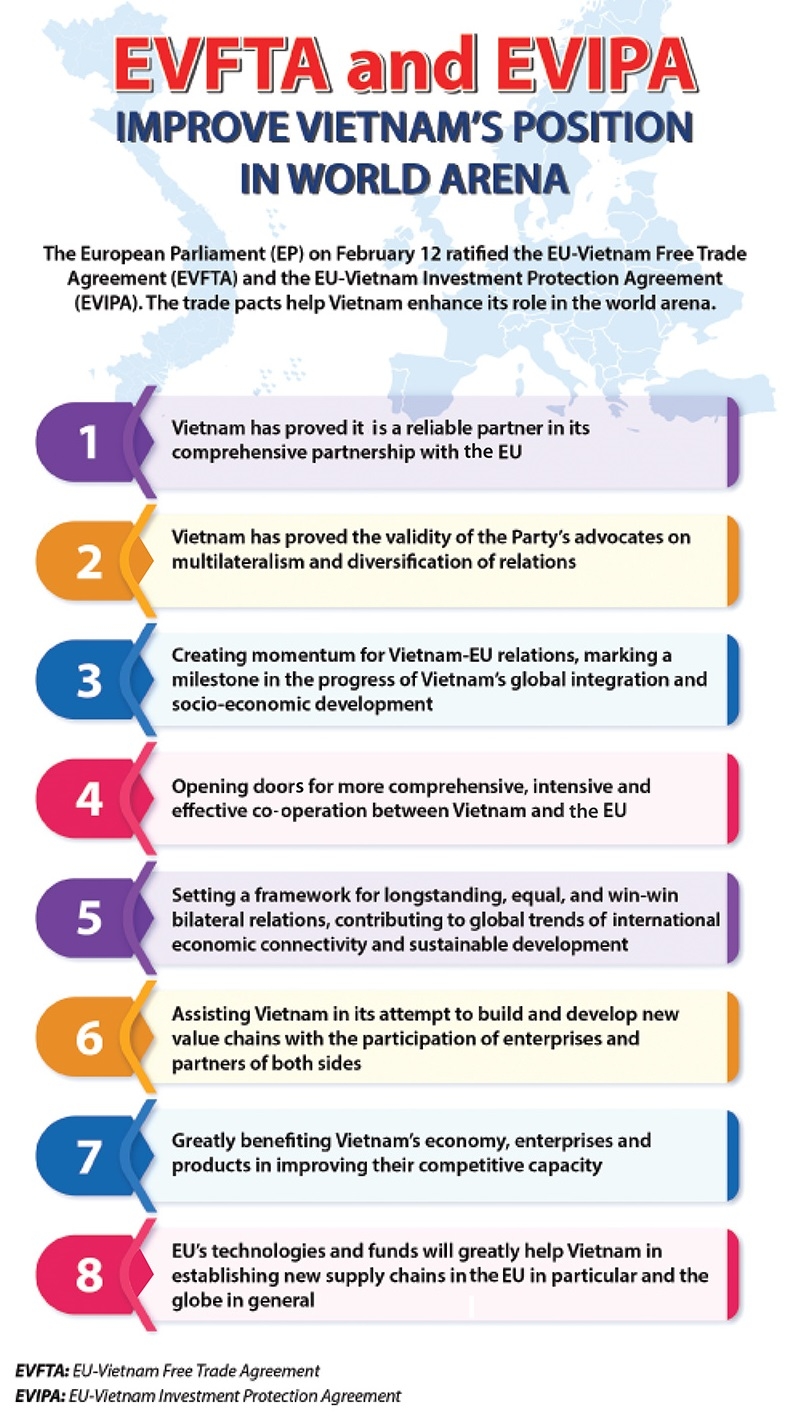Doors open for free trade with the EU
Last Wednesday the European Parliament (EP) officially adopted the EU-Vietnam Free Trade Agreement (EVFTA) and the EU-Vietnam Investment Protection Agreement (EVIPA) in a historic vote in Strasbourg, presenting a major milestone in the bilateral relationship between Vietnam and the EU.
The EP gave its consent to the EVFTA with 401 votes for, 192 votes against, and 40 abstentions.
The “most modern, comprehensive, and ambitious agreement ever concluded between the EU and a developing country” will contribute to setting high standards in the region, and could lead to a future region-to-region trade and investment agreement, said an EP statement.
The EVFTA is “a strong signal in favour of free, fair, and reciprocal trade, in times of growing protectionist tendencies and serious challenges to multilateral rules-based trade,” it continued.
The next and final step before the EVFTA can enter into force is a vote in Vietnam’s National Assembly, expected to take place in May. If greenlit, the agreement will take effect one month after Vietnam and the EU have notified each other that the legal procedures have been completed.
Furthermore, the EP also agreed by 407 votes for, 188 against, and 53 abstentions to the EVIPA, providing an investment court system with independent judges to settle disputes between investors and state.
“This is a historic moment for EU-Vietnam relations, and one which will open the door to a new chapter of increased trade and investment between our two sides,” said Nicolas Audier, Chairman of the European Chamber of Commerce in Vietnam (EuroCham).
“It will enable European business to be at the forefront of the next phase of Vietnam’s socio-economic development, and ensure that Vietnamese companies and consumers have privileged access to European markets, products, and services. Likewise, EU companies will have greater access to Vietnam’s fast-growing market,” he said.
European Commissioner for Trade Phil Hogan also commented, “The EU-Vietnam agreement has a huge economic potential. A win for consumers, workers, farmers and businesses. And it goes well beyond economic benefits. It proves that trade policy can be a force for good. Once in force, these agreements will further enhance our potential to promote and monitor reforms in Vietnam.”
According to the EP, Vietnam is a booming, competitive, and connected economy with almost 100 million citizens, a growing middle class and a young and dynamic workforce. Vietnam is also one of the fastest-growing economies in the ASEAN with an average GDP growth rate of around 6.51 per cent from 2000 until 2018. Vietnam is also one of the most open and pro free trade economies in the region.
 |
| Source: VNA |
Pushing trade forward
The EVFTA is expected to be a major driver of Vietnamese exports, and help the country to diversify its markets and exports, especially its key staples such as agro-forestry-fishery products, electronics, footwear, and garments and textiles. Currently, Vietnam’s exports rely on its traditional markets like China, the United States, Japan, and South Korea.
Last year, Vietnam’s largest export markets were the US ($60.7 billion), the EU ($41.7 billion), China ($41.5 billion), the ASEAN ($25.3 billion), Japan ($20.3 billion), and South Korea ($19.8 billion).
The agreement will remove virtually all customs duties between the two parties over the next 10 years, including on Europe’s main export products to Vietnam like machinery, cars, poultry, and chemicals.
It extends to areas such as banking, maritime transport, and postal services, where EU companies will have better access. Companies will also be able to bid on public tenders put out by the Vietnamese government and several cities, including Hanoi. The deal also safeguards 169 emblematic European products.
MEP Geert Bourgeois, who is in charge of steering agreements through the bloc’s parliament, said the EVFTA aims to eliminate 99 per cent of tariffs within seven years. This should result in €15 billion ($16.37 billion) a year in additional exports from Vietnam to the EU by 2035, while EU exports to Vietnam would expand by €8.3 billion ($9 billion) annually.
“Of course, these EU exports result in around 14,000 new, well-paid jobs here in the EU,” Bourgeois said. “Vietnam is a vibrant market with a young population. With an economic growth of 6-7 per cent every year, Vietnam is very interesting for European investors.”
According to the General Statistics Office, in 2019, EU member states spent $41.7 billion importing Vietnam’s goods, holding 15.8 per cent of Vietnam’s total export value of $263.45 billion.
These markets also exported goods worth $14.8 billion to Vietnam, meaning the country’s total import turnover from them accounted for 5.8 per cent of Vietnam’s total import turnover of $253.51 billion from global markets.
According to a study by Vietnam’s Ministry of Planning and Investment, the EVFTA will help Vietnam’s exports to the EU increase by additional 20 per cent in 2020, 42.7 per cent by 2025, and 44.37 per cent by 2030. It will also help raise Vietnam’s imports from the EU by 15.28 per cent in 2020, 33.06 per cent by 2025 and 36.7 per cent by 2030.
The deal will also enable Vietnam’s GDP ascend by an additional 2.18-3.25 per cent during 2019-2023, 4.57-5.3 per cent during 2024-2028, and 7.07-7.72 per cent for the 2029-2033 period.
Investment boost
According to the German Industry and Commerce Vietnam (GIC), the EVFTA is very important for the German economy, and the country is Germany’s second biggest trading partner in Southeast Asia.
“More than 4,000 German companies have already been exporting to Vietnam, of which 69 per cent are small and medium-sized enterprises. In times of increasing international trade conflicts and erosion of the world trade rules, the new agreement is an essential sign for rules-based trade and fair competition,” said the GIC in a statement released last week.
Recently, EuroCham asked its 1,000 members how the EVFTA would affect their trade and investment plans in Vietnam. Their responses painted a strong, positive, and optimistic picture.
Most said that the EVFTA would have either a “significant” or “moderate” impact on their business or investment plan in both the medium-term (78 per cent) and long-term (85 per cent). Furthermore, 72 per cent agreed that the EVFTA will help Vietnam to become a hub for European companies in the ASEAN.
On top of the clear economic benefits of the EVFTA, EuroCham’s members believed that it will have a positive impact on a range of social and environmental issues, from welfare (88 per cent) and environmental protection (85 per cent) to knowledge transfer (88 per cent) and workers’ rights (65 per cent).
“Experts agree that the EVFTA will have a positive and significant impact on Vietnam’s social and economic development,” said Audier of EuroCham. “Vietnam’s exports to the EU are set to rise around 50 per cent, with imports also seeing significant growth.”
Swedish glove-maker Hestra said the EVFTA will give EU companies like it a helping hand.
“With the EVFTA in place, we would look to invest in a new factory in Vietnam with 200-400 employees, alongside our current factory. This would not only be a good opportunity for our company, but also create more job opportunities for the local community,” said one of Hestra’s owners Svante Magnusson.
Hestra, which exports its gloves to over 30 countries worldwide, will benefit from the removal of EU tariffs on gloves of up to 9 per cent. This will make it easier for Hestra to export its products to the EU.
Besides this, the agreement’s new rules of origin will make it easier to trade products tariff-free when they include inputs from other countries the EU has trade agreements with. This will benefit textile producers such as Hestra.
The EU is one of the most important sources of foreign investment for Vietnam. According to the Vietnamese Ministry of Planning and Investment, investors from 23 out of 28 EU member states have registered approximately $24 billion for nearly 2,200 projects in Vietnam.
| The EVFTA and the IPA were initially negotiated as a single text, but in 2018 the EU and Vietnam decided to split them, following the approach chosen for the trade and investment agreements with Singapore. The EVFTA covers exclusive EU competences, and can therefore be ratified by the EU alone, without involving the member states. The European Commission will have a mandate to implement it straightaway, thereby removing trade tariffs gradually until 2035. The EVIPA covers non-direct (portfolio) investment and investor-state dispute settlement mechanisms. These are shared competences on which the EU shares decision-making powers with member states, meaning that the agreement must also be ratified by them. The two texts were signed by the EU and Vietnam in Hanoi last June. |
What the stars mean:
★ Poor ★ ★ Promising ★★★ Good ★★★★ Very good ★★★★★ Exceptional
 Tag:
Tag:
Themes: EVFTA & EVIPA
Related Contents
Latest News
More News
- Global partnerships key to Vietnam’s IFC development (December 26, 2025 | 16:18)
- Vingroup pulls out of bid to invest in North-South high-speed railway (December 26, 2025 | 11:42)
- Strengthening supply chains through trade promotions and customs reform (December 24, 2025 | 14:00)
- PM orders investment model for North–South high-speed rail (December 22, 2025 | 17:43)
- LS Eco Energy to invest in Vietnam rare earth sector (December 22, 2025 | 17:31)
- Government moves to establish International Financial Centre (December 21, 2025 | 21:00)
- Vietnam's IFC to target global investment flows (December 21, 2025 | 18:00)
- Two national hospitals expand capacity with new facilities (December 20, 2025 | 09:00)
- Ha Tinh breaks ground on major Vingroup industrial and energy projects (December 19, 2025 | 18:24)
- EVN launches major power infrastructure projects nationwide (December 19, 2025 | 18:17)

































 Mobile Version
Mobile Version